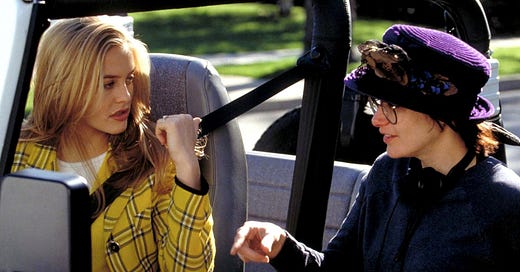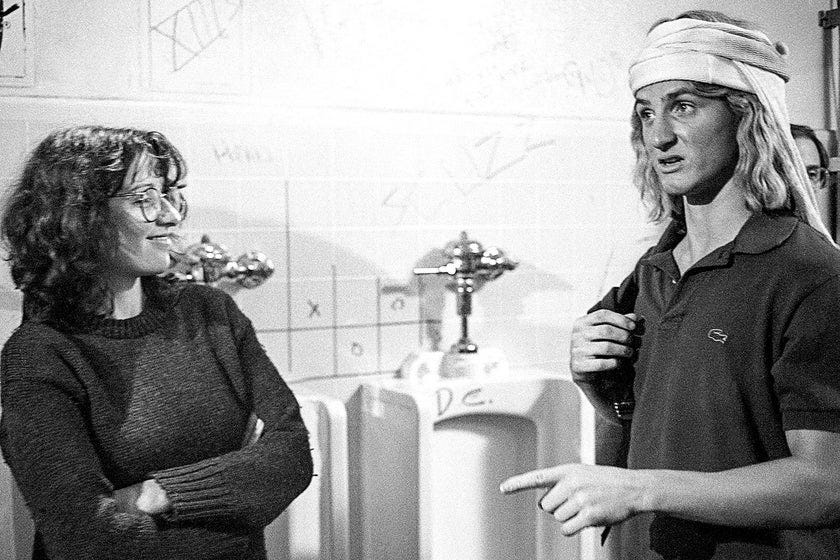How Amy Heckerling Brought 'Clueless' and 'Fast Times at Ridgemont High' to Life
An excerpt from Kevin Smokler's new book of interviews with female directors, "Break the Frame."
Editor’s note: Buy Kevin’s book! Break the Frame is a wonderful collection of interviews with filmmakers like Barbara Kopple, Aline Brosh McKenna, Julie Dash, Anna Boden, and dream hampton, now out from Oxford University Press.
Amy Heckerling is the only filmmaker I spoke to who directed the defining movie of a generation— twice. Her 1982 debut Fast Times at Ridgemont High, an ensemble film of six high school students growing up too fast in the San Fernando Valley In the early years of Ronald Reagan’s America, kicked off the teen movie boom of the 1980s and became the cool senior in the cinematic high school that would later include The Breakfast Club, Pretty in Pink, and Heathers. Fast Times received induction into the Library of Congress’s National Film Registry in 2005.
In 1995, Heckerling wrote and directed Clueless, which did for early millennials what Fast Times had done a decade before and is likely headed for that same National Film Registry any year now.
As a screenwriter, her accomplishments include the minor fact of adding the phrase “As if!” to the English language.
Amy Heckerling spoke in 2015 and early 2020 from her home in New York City.
KS: Clueless takes place explicitly in Beverly Hills and the Valley. Fast Times was shot in the Valley and also in Santa Monica, but the story happens in a fictional place called Ridgemont. What was behind the choice to fictionalize Fast Times’ locations while making plain those in Clueless?
AH: The characters in Fast Times are based on real high school students that Cameron [Crowe] wrote about in his book. At the very least we had to make the movie its own thing to protect their privacy. To shoot in L.A. and not in San Diego, where the high school actually was, that decision was already made when I came on. It was my first movie and Cameron’s first movie. And Fast Times was the kind of small- budget film where nobody was being put up in a hotel and everyone drove themselves.
KS: Ridgemont seems like a small town and the Los Angeles of Clueless feels like a giant sprawling metropolis, like in the scene where the characters argue about who will drive who home from the party in the Valley . . .
AH: The directions argument in Clueless I’m afraid comes straight out of Jane Austen. There’s a scene in Emma where they argue over who will leave with whom in which carriages. Reading it, you know that even back then, driving home with someone was really about who gets private time with who, not just who is going in which direction, but who gets to spend time alone with who. The trick is convincing that person that it was an intelligent solution. It’s the same old story, whether you’re talking about a carriage or driving or an Uber.
KS: Where did the choice to begin and end Fast Times at the same mall come from?
AH: I was not, at that time, a mall expert. The theme of the movie was the characters were growing up too fast. They were all working people with jobs, even though they were really still children. I liked the action all being in one place on a single boulevard or consolidated all in the same building under one roof, where kids at different jobs would walk past and run into each other all wearing their uniforms from work.
That idea came from Mean Streets. After all the adventures and romance that happen in this one neighborhood, you see the neighborhood closing down, the lights going off in the buildings, the neighbors closing their shades. I wanted to do the same with the mall in Fast Times. We’ve gone on this journey, now we’re saying goodbye. There’s something deeply satisfying about that.
KS: I love how, in your work, you seem particularly drawn to characters who are forces of nature, where that character can walk down a hallway and pull the attention of the whole movie towards them. Jeff Spicoli is that kind of character. Cher Horowitz is that character too.
AH: Scarlett O’Hara might have not been taken seriously, but that’s a pushy, self- centered female who is a force of nature, who will do whatever it takes to keep her house and try to get somebody else’s man. A lot of the Bette Davis characters are not people that you go, “Oh, I want to be friends with her.”
KS: Exactly. But unlike those examples. Cher Horowitz manages to be charismatic, self-centered, and also admirable at the same time.
AH: Well, we got to take our hats off to Jane Austen for that because she created a character in a time when women were not so strong, who was a very strong character and not perfect, but grows and never doubts her abilities and her strengths, the freedom to do things or get things done.
KS: Even though you didn’t write Fast Times at Ridgemont High, it seems like there’s a parallel between Jeff Spicoli and Cher Horowitz, an unshakable belief that things will turn out okay if you just have the right attitude or frame of mind.
AH: Well in Fast Times, of course, the most successful character was Spicoli and Spicoli didn’t even understand that people were mad at him. And that cracks me up. So I thought these characters, they can’t even understand somebody being mad at them, not even having the concept that the world may not be a great place.
And then I thought, “Well, what’s the story of a person like that? Where have I ever read of them or seen them in film?” I remembered in college that I had read Emma, and I reread it and was like, “Fuck, this is great.” But it also felt so like I had seen it a million times, too, because I remembered when I was a little kid and I watched Gidget. And at one point, a goofy exchange student comes and Gidget does a makeover on her because she’s so out of it. And when she’s made over, she becomes really popular and then she starts to like Gidget’s boyfriend. Gidget thinks she can do everything and now it’s, “Oh no. I created a monster.” She can make everybody’s lives better, not knowing that she’s screwing up her own life.
KS: What it’s like for you that one of your great creative legacies will not only be the movies that you made and the actors that you discovered, but simple phrases like “As if!”?
AH: I had an ex-husband once and he was a comedy writer and he’d think in terms of zingers and buttons. My brain doesn’t work that way. In school I never knew, like, “How are these people standing around at recess and they talk to each other?” So from a very early age I was writing down snippets of things people said because it confused me. Like how do they know to do that?
I had friends that were younger and that were actors, and they had a certain way of speaking. And I watched MTV all the time when they used to have videos. And there were rap songs that had specific speech patterns and vocabulary and I just compiled my own dictionary. I don’t know if I told you about that.
KS: You hadn’t, no.
AH: Because when you’re writing and somebody goes, “Oh wow. That’s great,” well, nobody just says “great.” They say it specific to where they come from, how old they are, what their other friends are saying, what profession they’re in, what school they go to. So there are five billion ways of saying something positive about something, but which one you choose becomes very important. And it tells you too much about who you are. I feel like there are certain words that are in certain films I did, that no matter how old I am or what year it is, I’m kind of allowed to say them, you know? Like I got some sort of bus pass for it for whatever.
Certain kinds of speech go with different people. One of the most fun things for me was in Clueless, the Christian character because I was able to incorporate speech patterns from old movies that I loved. And there was a little glimmer of the Rat Pack being in style in the nineties for a minute.
KS: When he arrives to pick Cher up for their date and you shoot him from the side and he’s still wearing the hat and he spins on his heel and looks at Cher’s dad and says, “Nice pile of bricks you got here, man.” It’s that whole character in eight words.
AH: The Christian character is somebody that is creating a persona because he was a creative guy, but also hiding something. He would make a whole other speech, a way of language for himself. He would have a whole other way of dressing from the others. I just put him into that world so that I could have fun with all the 1930s slang.
Kevin Smokler is the author of 3 books on pop culture including Brat Pack America: A Love Letter to 80s Teen Movies (2016) and Practical Classics: 50 Reasons to Reread 50 Books you Haven’t Touched Since High School (2013) and the co-director of the award winning 2022 documentary film Vinyl Nation. He lives in San Francisco with his wife and many books, vinyl records, and movies directed by women.








This is so fun! I hadn't realized that the whole directions-home argument came directly from Emma.
Wow, great piece. May now finally hit play on Fast Times!